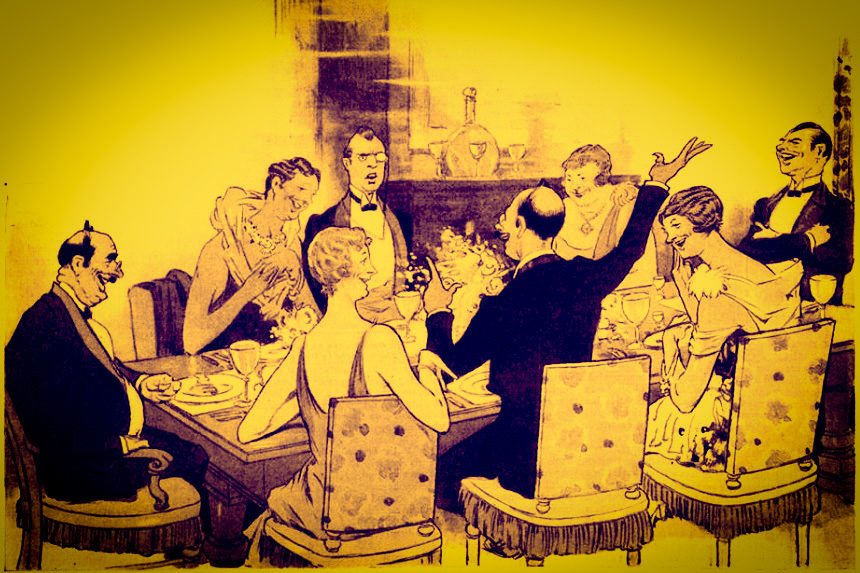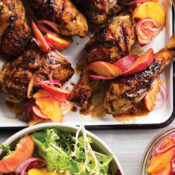“I like to keep it casual, obviously,” she said. “As you can see, it’s a quarter after seven and we don’t have food on the table yet.” My friend Megan was aproned and buzzing around the kitchen while music from the band Beach House’s latest album emanated from a bluetooth speaker nearby. In another room, an enormous charcuterie board kept a crowd of young, stylish dinner guests at bay, as did an impromptu bar covered with bottles of red blend.
I was finally attending one of her supper club nights. A rising star baker and chef at an acclaimed local restaurant, Megan has been experimenting with recipes on her friends at monthly dinner parties around the city for a year or so. This one was a special occasion: a mutual friend’s birthday.
I’ve cooked with and for family and friends in various contexts for decades, but this dinner party was different. It was an event.
In attendance were some friends, friends’ exes, strangers, and acquaintances with whom I have awkward sexual histories. Mostly everyone was young and dressed in impractical, vintage clothing from thrift stores. We were passing time on the balcony, visiting raucously and vaping cannabis, when a friend told me she and her fiancé would need to be awake at 5 a.m. for work and it was already past their normal bedtime. “I would hate to be a dick,” she said, “but if this dinner doesn’t get started soon, I might have to ask if we can take ours to go.”
Of course, that wasn’t going to be an option, but luckily — as though our hostess had intuited the conversation and correspondingly timed the evening for maximum tension — it was time to be seated.
Almost a century ago, in her iconic volume Etiquette in Society, in Business, in Politics and at Home, the authority on how to behave, Emily Post, wrote that “to give a perfect dinner of ceremony is the supreme accomplishment of a hostess!” Much has changed, culturally, since Mrs. Post doled out her indisputable advice for entertaining, but a few things have not: we still enjoy eating dinner and many of us like to do it with company.
Post’s rules for hostesses assumed that anyone who would attempt a dinner party might have at her disposal a butler, chef, secretary, chambermaid, footmen, and valets. She would need engraved invitations, stark white, unblemished table linens, and polished silverware. Her guest list would require a careful balance of new and old money, bombastic socialites and quiet intellectuals.
The dinner party of the early century was a tradition steeped in luxury, a routine for flaunting one’s social and material assets. Some have lamented its demise over the years, mourning the loss of keenly executed gatherings that featured Tiffany silver and sloshed celebrities. (Could it even be the end of conversation as we knew it?) Those kinds of posh events could be a thing of the past. I wouldn’t exactly know, since I’ve never been to one. But dinner parties needn’t be reserved for the rich and famous. After all, the two most important components are food and people, and these can be provided in manners both creative and inspiring without spending a fortune.
At the supper club, Megan’s menu comprised of four courses plated and served to the table of 20 or so guests. This might seem like a cost-prohibitive endeavor, but we each paid 20 dollars to take part. By sharing the cost, we could all dine like aristocrats with millennial wage money. Megan made us roasted Brussels with labneh sauce, tomato risotto, maiale al latte, and candied fennel and carrot cake with browned butter hazelnuts and honey Italian meringue buttercream. Supper club nights give her the chance to try new things in the kitchen.
The difference between dinner and a dinner party, foodwise, isn’t immediately obvious, but the menu should induce excitement in your guests. Emily Post refers to “fancy dishes” that must be served in lieu of “plain food.” To host a successful dinner party, you don’t have to dig through a library of cookbooks and scour your city’s farmers’ markets in an effort to turn your home into a fusion tapas restaurant. But you should bring something to the table that turns heads, whether it’s a spicy slow-braised main course or a gravity-defying dessert. If your guests are bringing food too, don’t let them steal your spotlight.
The other component of a dinner party — people — should also break with your normal dinner routine. If you want to curate an unforgettable evening of stimulating conversation, your guest list should reflect some social diversity. In spite of my proposals to update and democratize the dinner party, the purpose of the event should retain the same spirit as that of Emily Post: to forge socialization and community. Of course, you’ll want to avoid sparking heated political discourse or cramming a too-awkward group into one room, but you also want to breathe fresh air into everyone’s social lives. Finding the perfect balance can be tricky.
Fashioning formal traditions into your gathering can lend it a tone of importance. At the supper club, guests were encouraged to give a toast to the birthday guest of honor in between courses. Though we weren’t especially familiar with public speaking at a party, hearing people command the room with stories and well-wishing gave the dinner an elegant dynamic. If you have a theme, or some other important reason for gathering, use it to engage your guests throughout the dinner. You could even invite some particularly interesting academic or comic to give an after-dinner speech, in which they entertain your crowd with an edifying or humorous presentation while you put finishing touches on the dessert.
The goal of your dinner party should be to provide an atmosphere for fun surprises and novel interactions. Though it might take some hard work and ingenuity, providing good food and company should never require a small loan.
By the end of the supper club, my friends who had earlier groaned about a 5 a.m. wake-up time seemed to forget that they needed to be home at all. I left before the carrot cake was cut (a decision that will haunt me for years to come), but the evening left me inspired and believing that elegance should no longer be confounded with expense.
Featured image: Illustration by M.L. Blumenthal from the April 2, 1927, Post (©SEPS)
Become a Saturday Evening Post member and enjoy unlimited access. Subscribe now




Comments
Bob, your comments are right on target regarding Nick’s well researched and thought out feature here. My parents had dinner parties when I was very young, but they kind of stopped around 1966; basically when mid-century (and The Dick Van Dyke Show) ended.
Though well into the 20th century, the ’60s still held on to 19th century century traditions such as hats for men, hats and gloves for women, and dinner parties. It would be the last decade for all of these. With everyone “super busy”, “no time”, crazy schedules (work and otherwise), societal upheaval and more, the relaxed American dinner party bid adieu with the Johnson Administration never to return.
My idea of the perfect dinner party is a mix of people you know and people you don’t, a good meal, drinks, and then everyone sits around the living room while the hosts and guests get up and sing, dance, tell jokes, and play the piano.
Apparently my idea of the perfect dinner party I got from reruns of The Dick Van Dyke Show.